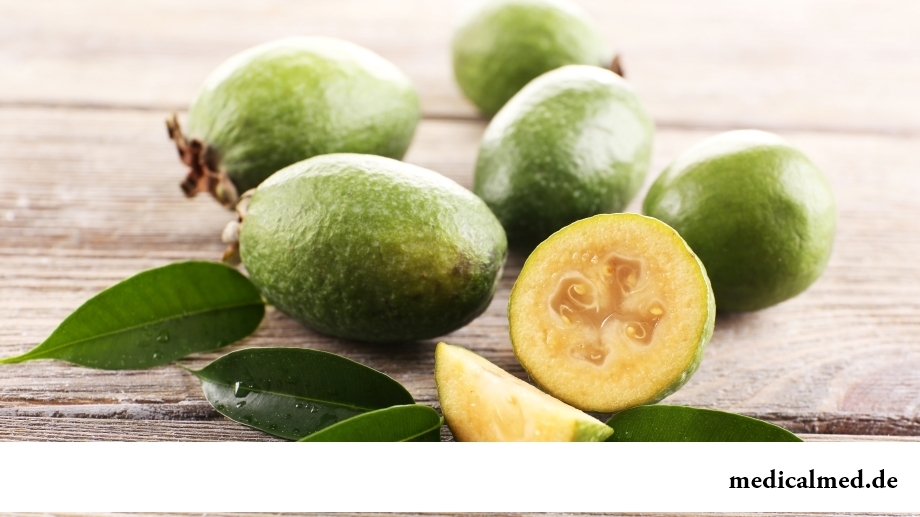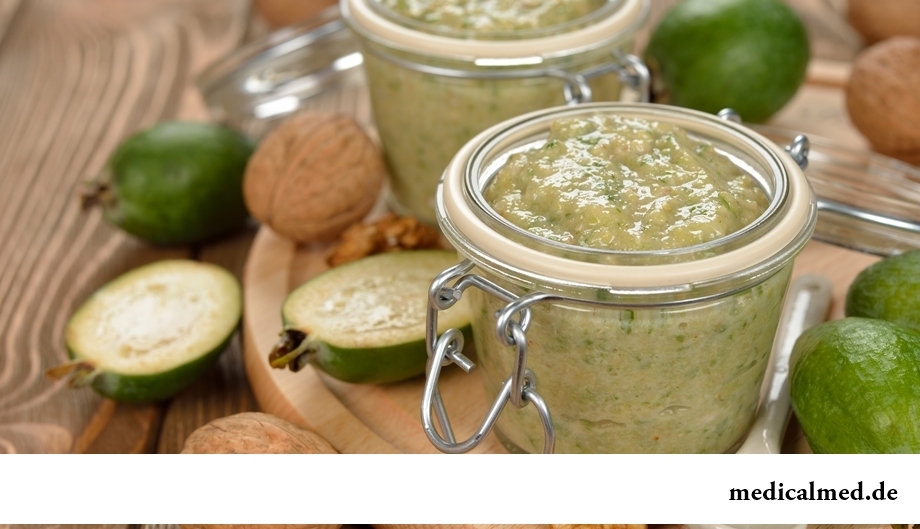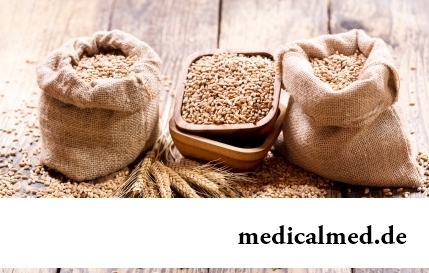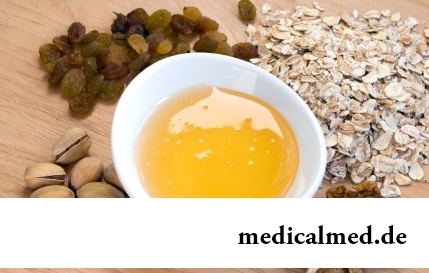





Feijoa
Feijoa – a small evergreen bush with dense sprawling krone. The plant is from tropics, and in the European countries for the first time appeared in 1890. Is later than a feijoa from France delivered to Transcaucasia, Azerbaijan, Turkmenistan, to the Crimea and Georgia where it perfectly got accustomed.

For feijoa it was open by the Brazilian botanist Joao da Silva (Silva) Feyjo. Later the botanist Otto Karl Berg gave the name to this plant in honor of the pioneer.
The feijoa – a thermophilic plant, however, as a matter of experience of cultivation in Krasnodar Krai and the Crimea, can take out frosts to-10 ˚С.
The bush blossoms in June-July, and fruits of a feijoa ripen in October-November. The feijoa plentifully fructifies. Even from houseplants collect up to three kilograms of fruits, and from bushes on a plantation – to thirty kilograms.
The fruit of a feijoa represents the oblong greenish or yellowish polyspermous berry by the size reaching five-seven centimeters. Depending on a grade the weight of a fruit varies from 25 to 125 grams. Ripe fruit has juicy, slightly sourish pulp with small, oval seeds. Its peel tart on taste and rather dense.
Fruits of a feijoa collect immature. The peel of crude fruits has characteristic glossy gloss. They ripen at storage or when transporting. Useful properties of a feijoa at such ripening, according to specialists, are not lost. Ripe fruits quickly enough spoil. Feijoas smell of mix of a wild strawberry and pineapple and have sweet-sour taste. Pulp of ripe fruit has to be transparent. If pulp white, then a feijoa did not ripen yet and if brown, then the fruit is already spoiled.
Nutrition value and caloric content of a feijoa
Hundred grams of a feijoa contain 86 g of water, 1 g of proteins, 0,8 g of fats, 10 g of carbohydrates and 0,74 g of ashes.
8 mkg of B1 vitamin, 32 mkg of B2 vitamin, 0,29 mg of Niacinum, 0,23 mkg of B5 vitamin, 0,05 mg of B6 vitamin, 38 mkg of folic acid are a part of fruits.
100 g of fruit contain 155 mg of potassium, 17 mg of calcium, 3 mg of sodium, 9 mg of magnesium, 20 mg of phosphorus, 80 mkg of iron, 70 mkg of iodine, 85 mkg of manganese, 55 mkg of copper, 40 mkg of zinc.
In 100 g of a feijoa about 50 kcal contain.
Advantage of a feijoa
It is difficult to revaluate advantage of a feijoa. First of all, the advantage of a feijoa is that iodine in these berries contains much more, than in any other products. On the content of iodine this fruit costs on an equal basis with seafood and a laminaria. Iodine in its structure contains in a type of water-soluble connections. Bushes of a feijoa receive it from the sea breezes rich with flying iodine. Therefore true advantage to an organism bear only fruits which grew by the sea under the sun.
In addition to iodine, sucrose, cellulose, pectinaceous substances as a part of a feijoa contains more, than in other berries.
In medicine these berries apply at avitaminosis, inflammatory diseases of a digestive tract, at pyelonephritis, bronchitis, a bazedovy disease, gout, at painful periods, rheumatism, vomiting, diarrhea. The regular use of fruit promotes decrease in concentration of cholesterol in a blood plasma and to decrease in the high ABP. At flu and catarrhal diseases it is useful to use a feijoa with warm tea in the form of jam. The boiled, fresh or wiped fruit are very useful at atherosclerosis.
Essential oils of a feijoa are applied dermatology as effective anti-inflammatory drug. Extract of these fruits has the expressed antifungal and antibacterial properties. Useful properties of a feijoa quite often use in cosmetology. Cosmetic masks on its basis possess the rejuvenating, nutritious and antiinflammatory action.
Bark and leaves of bushes of a feijoa are used as an antiseptic agent and disinfectant for healing of wounds and ulcers. Broth of leaves kills a dentagra and saves from bleeding of gums.
The peel of these fruits contains catechins and leykoantotsiana – strong antioxidants. The regular use of a peel reduces risk of development of oncological diseases. Therefore it is the most useful not to peel this fruit of a peel and to eat entirely. However the peel spoils taste of a feijoa a little because of tart, astringent taste therefore it is the best of all to dry it and to make with tea.
It is daily recommended to eat not less than four fruits.
Use of a feijoa
Most often fruits of a feijoa are eaten crude, but some culinary specialists cook compotes, desserts, marinades, jam from these fruit, add them to fruit and vegetable salads. In feijoa salads perfectly is in harmony with citrus and oily fruit, and also with carrots, beet and apples.

The excellent dessert turns out from the fruit wiped on a grater mixed with sour cream or yogurt.
Fruit quite often use for preparation of wine and various tinctures, and also as a stuffing for pastries.
Very often feijoas fray with sugar. At a zasakharivaniye taste and useful properties of a feijoa remain invariable.
Because of high concentration of sugar fruits are contraindicated at a diabetes mellitus and obesity.
Feijoa storage conditions
The feijoa can be stored in the refrigerator from one to two weeks. At storage they lose moisture and become more sweet.
The 74-year-old resident of Australia James Harrison became blood donor about 1000 times. It has a rare blood group which antibodies help to survive the newborn with a severe form of anemia. Thus, the Australian saved about two million children.

One of the major chemical processes happening in a human body are oxidation reactions. They go with participation of fats...
Section: Articles about health
Aging — natural and inevitable process. Over time our skin loses elasticity, on it saggings are formed, the face form loses former clearness. The procedure of nitevy lifting (nitevy tightening) can successfully solve this problem. In order that it is better познако...
Section: Articles about health
Ability of an organism to resist to adverse environmental factors (to impact of temperature drops, humidity and pressure, to the attacks of causative organisms, etc.) directly depends on what the person eats. Business here not only in that cells of a body received a necessary set of nutrients, vitamins and microelements. Scientists established that such components which are capable to influence negatively immune system, in connection with also are a part of foodstuff...
Section: Articles about health
Season of activity of viral infections in the heat. Everyone can get sick, but probability of this unpleasant event it is possible and it is necessary miny...
Section: Articles about health
Traveling all over the world, many try to try the most exotic dishes of national cuisines. There is even a so-called gastronomic tourism which, according to gourmets, not only allows to receive new feelings, but also is capable to show life the friend...
Section: Articles about health
The words "disease" and "patient" not without reason come from one root – "pain". As a rule, symptoms of illnesses thoroughly spoil to patients life. However from this rule there are exceptions. Some diseases are shown by signs which can cause even positive emotions. It is a pity only that the majority of such illnesses are heavy and incurable....
Section: Articles about health
Smack in a mouth can arise in the natural way – as a result of lack of morning hygiene or reception of the corresponding food. Odn...
Section: Articles about health
"Epilepsy" doctors made the diagnosis in antique times. Displays of an illness and pattern of its development are very well studied. However for nonspecialists this disease remains to not less mysterious, than in the ancient time. Many delusions are connected with epilepsy...
Section: Articles about health
The naturopathy sometimes moves as the new direction of medicine, something like fashionable hobby, and there is nothing farther from the truth. This most ancient direction, the word "naturopathy" is translated as "treatment by the nature", and, no doubt, treatment by natural gifts was the first and only, available to the person in ancient times. Despite modern achievements of medicine, the naturopathy remains urgent and today, anyway the person - a part of the nature, and природн...
Section: Articles about health
Condition of lips (their morbidity, outward) – one of indicators of health of the person. Peeling, dryness, pallor, and also трещ...
Section: Articles about health
Separate food - the system of meal based on digestion physiology which is carried to improvement methods. According to nutritionists, the separate use of the carbohydrate and proteinaceous products demanding different conditions of assimilation helps to get rid from Bol...
Section: Articles about health
Each woman has preferences in the field of use of those goods which help us to look good, feel young and effective. Besides: selection process of favourite perfume, shampoo or decorative cosmetics already lightens the mood and serves as a peculiar stress medicine. Happens very offensively when the acquired perfumery and cosmetic products not only do not meet our expectations, but also becomes the reason of problems with health. Sources неприятн...
Section: Articles about health
The popular expression "run from a heart attack" became the motto of the people supporting active lifestyle. Moreover, run became peculiar...
Section: Articles about health
The concept "gluten" (differently, a gluten) combines group of the proteins which are a part of rye, barley and wheat. For most of people the use of the food stuffs containing a gluten not only is safe, but also it is very useful. Nevertheless, there is a number the myth...
Section: Articles about health
Diseases of joints often begin imperceptibly for the person. The first stages of destruction of the cartilaginous tissue providing soft and free sliding of heads of bones in joint bags proceed slowly and absolutely without serious consequences. Especially unpleasantly for the fact that this process is not connected with advanced age: degradation of joint surfaces is, as a rule, noticeable after 30 years. It means that practically each able-bodied person at any time can face sad results...
Section: Articles about health
For many women the word "fat" sounds as a sentence. In aspiration to an ideal figure they try to exclude, first of all, from with...
Section: Articles about health
The climax, or menopause is the normal process of the termination of genital function of the woman which is followed by serious hormonal changes in an organism. Usually the menopause begins at the age of 50-55 years, but characteristics of this process are very individual. T...
Section: Articles about health
According to doctors, more than a half of men of 25-50 years suffer from frustration of the urinogenital sphere, but the minority sees a doctor from them. And in vain - even the insignificant discomfort in the field of generative organs can serve as a symptom of an illness fraught with grave consequences for health. So - after 40 years - it is easy for most widespread disease of the sexual sphere of men to pass the first symptoms of prostatitis (weight in the bottom of a stomach, decrease in a libido), having written off for overfatigue and fatigue. Let's consider...
Section: Articles about health
All the known slogan "Protect Men!" arose not from scratch. In a sense, the nature created representatives of strong...
Section: Articles about health
The majority of gynecologic diseases prove three main signs, each of which speaks about need of a visit to the gynecologist. Certainly, it is possible to establish the exact diagnosis only after inspection, but on the basis of some signs it is possible пр...
Section: Articles about health
Memory is an ability of the central nervous system to fix, keep and as necessary to reproduce information on knowledge or skills received by the person or an animal during life. The mechanism of this process is up to the end not studied....
Section: Articles about health
People know that thermal sources have salutary force long ago. Treatment by natural waters is one and...
Section: Articles about health
Visit of doctors – business not the most pleasant, and many people do not hurry to undergo necessary planned inspections. Such behavior is extremely thoughtless and improvident. Our health is necessary not only to us: wellbeing of darlings, children, grandsons and престар...
Section: Articles about health
Let's begin with the fact that a separate illness which is called "adjournment of salts", just does not exist. In practice this household name of disbolism leading to development of a number of diseases. Pathological process consists that in an organism there is an accumulation of salts of uric acid (as a rule, owing to failure of a water salt metabolism or insufficiently effective work of secretory system)....
Section: Articles about health
Practice of use of table salt in the therapeutic purposes contains not one century. Appl are considered especially effective...
Section: Articles about health
For the person who daily since morning gathers for work it is very important to wake up vigorous and ready by day of work. Actually, each of us experiences difficulties with this, at first sight, simple business from time to time. On a condition of an organism after ночн...
Section: Articles about health
Statistically cystitis 25-30% of women up to 40 years have. With age this indicator raises, besides many do not get to statistics because do not see a doctor. The most sad that after the regular visits to doctors, long reception of antibiotics and life in the mode "it is necessary to take care" cystitis all the same is returned to a half of women. Symptoms of cystitis are unambiguous and it is impossible to confuse them with anything: bladder pain, burning at an urination, frequent desires to go to a toilet, a vynuzhd...
Section: Articles about health
